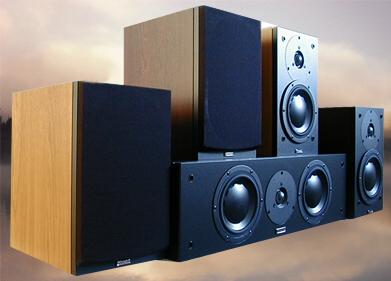Product Review - Dynaudio Audience
40 and C120+ Speakers
- February, 2000
Brian Florian
![]()
|
Dynaudio Audience Speakers Audience 40: One 1.1" soft dome tweeter, One 5" Mid/Bass driver with 3" voice coil. 53 Hz - 20 kHz, 4 Ohms nominal. $699/pair USA. Audience C120+: One 1.1" soft dome tweeter, Two 5" Mid/Bass drivers with 3" voice coils. 53 Hz - 20 kHz, 4 Ohms nominal. $749 each USA. |
| Dynaudio North America 1144 Tower Lane, Bensenville, Illinois 60106 USA; Phone 630-238-4200; Web http://www.dynaudiona.com |
Introduction
Having a modest income does not mean I’m cheap, though I’m sure my wife would beg to differ. Nor does it imply I have to put up with low-fi gear. But you could derive that I get excited when affordable products are born of more expensive lineage. If a company can examine its premier products, and find changes that can reduce cost substantially but performance minimally, I need to be there. When Dynaudio announced a retooling of their cost effective speaker line to complement its upscale Contour series, we simply had to listen.
I’ve heard Dynaudio before. I bet you have too, but maybe you didn’t know it. Ask a random panel of audio enthusiasts who Dynaudio is, and I’ll bet the majority recognizes them as a premier manufacture of speaker drivers used in various brands of speakers and favored by the do-it-yourselfer. One of the best sounding loudspeakers I have ever had the pleasure of hearing, the Totem Model One, uses a Dynaudio mid/bass driver. Truth be told, they are speaker builders in their own right, and proud of their hands-on approach to the whole thing. In fact, Michael Manousselis of Dyaudio America tells me that the driver-only business is less than 10% of what they do.
But can the care and attention put into the Contour line carry over into a speaker line roughly half the cost? I entered with high expectations and was not disappointed. If right about now you’re thinking “not just another set of speakers”, I assure you, you want to continue reading.
Nuts and bolts
Our review set consisted of four (two pair) Audience 40 monitors and a C120+ center channel. These are small speakers by any definition. Diminutive, but visually pleasing nonetheless. Despite its obvious esthetic appeal, a real wood veneer contributes appreciably to loudspeaker prices. The audible benefits of these are somewhat less concrete, some would say non-existent, and I’m sure will not be missed on the Audience line which opts for vinyl. But, this does not imply unattractiveness. In addition to the requisite black ash, various warmer shades of mock wood are offered. Whether you choose light cherry or dark oak, the front baffle remains a smart looking black. A telltale nod from my wife tells me these are a cut above in the aesthetics department.
Both the satellites and center are two way vented designs. Both use a 15cm (5") woofer (two on the C120+) and a 28mm (1.1") tweeter. The construction of both the satellites and the center call for an usually thick front baffle, 19mm for the 40s, 22mm for the C120+. A rap with the knuckle yields none of the frowned upon resonance. A single pair of plated binding posts and a flared port occupy the backs. All told, according to Michael, the Audience line “sacrifices” very little of the performance of its Contour line, the single biggest cost saving being in the vinyl finish. Some of the internal materials are a little less expensive, but each driver is still hand made. And my what drivers they are.

The mid-bass unit can be mistaken for none other than a Dynaudio original. You see, their driver designs call for dramatically oversized voice coils. A 3” coil is considered large for some subwoofers. For a 6” driver it is downright gargantuan. This is the reason for the cone’s appearance as not a cone but very nearly a dome. Referring to the diagram above and photo of the driver you can get a sense of how unusual this is. A traditional driver employs a cone diaphragm driven by a voice coil that moves through the center hole of a “doughnut” magnet. The Dynaudio driver’s diaphragm can’t be called a cone at all, and its voice coil moves over the outside of the doughnut. The advantages to doing so are numerous: The diaphragm has optimum drive and more control for greater speed and dynamics. But this begs the question, “why aren’t all speaker drivers made this way?" The biggest challenge presented by the design, and met by Dynaudio, is that the larger voice coil and former would normally result in substantially more mass and therefore a slower response, negating the positives of the design. By using unconventional material and a special hexagonal cut aluminum coil wire, Dynaudio creates a short but dense coil in a tight gap. Centering the magnet inside this coil further benefits the system by making better use of the magnetic energy. The shape of the diaphragm is no accident either. That’s not an oversized dust cap you see, it's all one piece. Dynaudio tells me that it is geometrically design for optimum response and dispersion. In a way, it is tuned: the “center” radiates the highest frequencies of the driver, the outer portion the lower tones. The circle of “notches” you see are where the voice coil former is attached.
Not to be outdone, the tweeter also brings some
special stuff to the table. Its bulbous
design yields more surface area than conventional designs and achieves a near 1800
dispersion for better off-axis performance. Its
voice coil is wound of pure aluminum wire and is damped by Magniflux, said to be superior
to ferro-fluid. The front chassis, 4mm thick,
acts as a heatsink.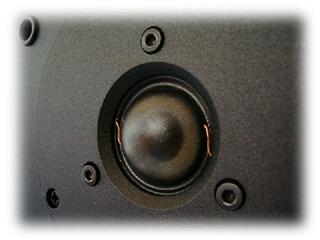
But this is all very academic. I love the inner working of things, but they are only the means to an end.
Wired for sound
The owners manual, among other topics, talks about not just the importance of a break-in period but of the importance or doing so gradually. I have long felt that bringing down the house with a brand new speaker was a bad idea and it's nice to see someone agrees. So, for the first three days, I played full-bodied music at a very modest level almost continually. I gradually added juice until things were swinging in full-tilt. Almost as if by clockwork, one week after hooking them up, I suddenly noticed a positive shift in the sound, telling me it was time to start listening . . . really listening.
And what I heard, in a word, was
“Correct”. By that I mean all five
speakers came across as very neutral with a welcome freedom from coloration. I’m kind of a closet opera fan, ever since
seeing "Amadeus" so many years ago. But soprano
opera is a hard thing for a speaker to get right, often reproduced as unnatural and harsh
(maybe that’s why few of my contemporaries enjoy it).
The 40s did not bring any uncertainty to the table, instead delivering
"The Magic
Flute" with confidence and accuracy.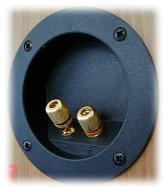
Along those lines is a certain relaxed nature to the ensemble’s sound, and I suppose some would say they are subdued. In a period where bright, forward (and in my opinion poor) speakers are the vogue, the Audiences are more than welcome in my house. Augmenting a rock-solid soundstage is its warmth and smoothness of the midrange, testament I believe to a well thought out and implemented 1st order crossover (demonstrating they can be as good or better than a complex 3rd or 4th order network). Bass is tight, natural, and can only further be described as surprising, given the size of these enclosures. Experimentation with placement is recommended, as I was able to coax usable output below the published spec (53 Hz).
Noteworthy is the fact that, though these are
ported designs, foam port plugs are provided for both the 40s and the C120+. In a supplement to the owner's manual, Dynaudio
states that the tonal balance of the speakers has been optimized for placement on stands 1
to 1.5 meters away from walls. Should you
place them on a bookshelf (heaven forbid) or (more likely) closer than the prescribed
distance to a wall, the plugs attenuate the added bass reinforcement. This is so simple, inexpensive, and practical,
it’s a wonder we don’t see it more often. After
experimentation, I elected to use the plugs on all five.
The rear pair benefited greatly, their position being the rear corners of the room.
Using the plugs made for a closer match in timbre to the fronts, permitting
palpable side imaging on material with aggressive soundfield use like
"Saving Private Ryan".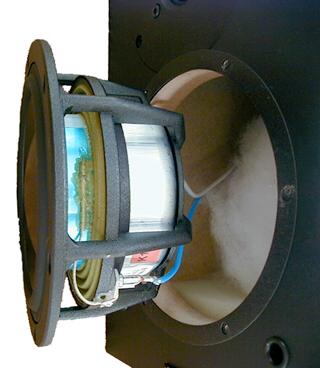
I’ve said these speakers are small, and indeed Dynaudio’s literature recommends them for small to medium-sized rooms. Do not think that these speakers are “cute” or “quaint”. They took what I felt was an excessive amount of signal for their size and didn’t complain. In my modestly sized listening room, Diana Krall - double bass and all, achieved a clean jazz club level without constrain. This is not to say that there isn’t a ceiling. Let's face it, a 15cm woofer can only move so much air. The point at which I began to hear compression was at a point well above what I consider sane listening levels. Remarkable is the fact that even at that point, the cones, demonstrating insane excursion, did not “smack” their limits: They’re under a lot of control. In home theater where this ensemble would undoubtedly be paired with a respectable subwoofer, a high-pass of say 50 Hz - 60 Hz would be perfect. My processor’s unusually high 90 Hz high-pass provided a relief which permitted these wonders to achieve so-called reference (and in my mind health-hazard) levels with clarity.
As a conclusion, I will simply say that I am impressed with the build, the components, and the sound of these speakers. The models reviewed may not be for everybody: They should be high on the list for people who favor an accurate and natural speaker over a brute force power-tower. Despite the quoted 4 Ohm load, I would not call them a particularly fussy speaker. My Yamaha receiver was able to drive them at modest volume with its speaker switch flipped to “4 Ohm”. Of course, the receiver's amplifiers ran out of steam at higher volume, as receivers do with 4 Ohm speakers, so I would recommend something more substantial, such as a nice outboard power amplifier, finances permitting. My Rotel power amp made an appreciably better mesh with all five pieces, yielding a totally controlled presentation.
It's a shame I have to break up the party and return these speakers after we have grown accustomed to them.
AUDIENCE 40
Sensitivity (2.83 V/1 m): 86 dB
Recommended Amplfier Power:
Small size rooms: 25 watts,
Medium size rooms: 65 watts,
Large size rooms: 125 watts
IEC Long Term Power Handling: 150 watts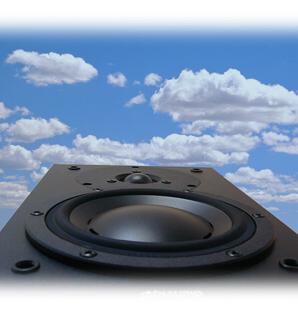
Impedance, Nominal: 4 ohms
Manufacturer Frequency Response (+/– 3 dB): 53 Hz – 28 kHz
Internal Cabinet Volume: 7 liters
Bass Principle: Bass reflex
Weight: 4.8 kg
Dimensions (W x H x L): 170 x 282 x 246 mm
Crossover: 2 way. The crossover is impedance corrected
Crossover Frequencies: 1800 Hz
Crossover Slope: Woofer: 6 dB/octave, Tweeter 6 dB/octave
Connection: CE-compliant insulated gold binding posts
Recommended Placing: Stand
Tweeter: 28 mm soft dome,
Magnetic fluid
4 mm die-cast aluminum front
Pure aluminum wire voice coil
Woofer: 15 cm polypropylene cone
75 mm pure aluminum wire voice coil
Cabinet: Front baffle 19 mm MDF
Port plugs included
AUDIENCE C 120+
Sensitivity (2.83 V/1 m): 86 dB
Recommended Amplifier Power: Small size rooms: 25 watts,
Medium size rooms: 65 watts,
Large size rooms: 125 watts
IEC Long Term Power Handling: 200 watts
Impedance, Nominal: 6 ohms
Manufacturer Frequency Response (+/– 3 dB): 37 Hz – 22 kHz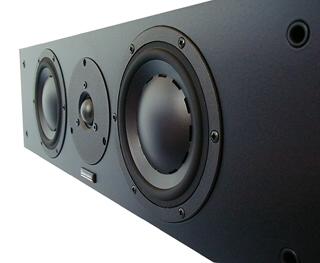
Internal Cabinet Volume: 17 liters
Bass Principle: Bass reflex
Weight: 11.4 kg
Dimensions (W x H x L): 570 x 165 x 320 mm
Crossover: 2 way. The crossover
is impedance corrected
Crossover Frequencies: 2510 Hz
Crossover Slope: Woofer: 6 dB/octave
Tweeter: 12 dB/octave
Connection: CE-compliant insulated
gold binding posts
Recommended Placing: On a stand
or underneath TV-set
Tweeter: 28 mm soft dome,
Magnetic fluid, 4 mm die-cast aluminum front
Pure aluminum wire voice coil
Woofer: 2 x 15 cm polypropylene cone,
75 mm pure aluminum wire voice coil
Cabinet: Front baffle 22 mm MDF
Port plugs included
- Brian Florian -
![]()
� Copyright 2000 Secrets of Home Theater & High Fidelity
Return to Table of Contents for this Issue.

